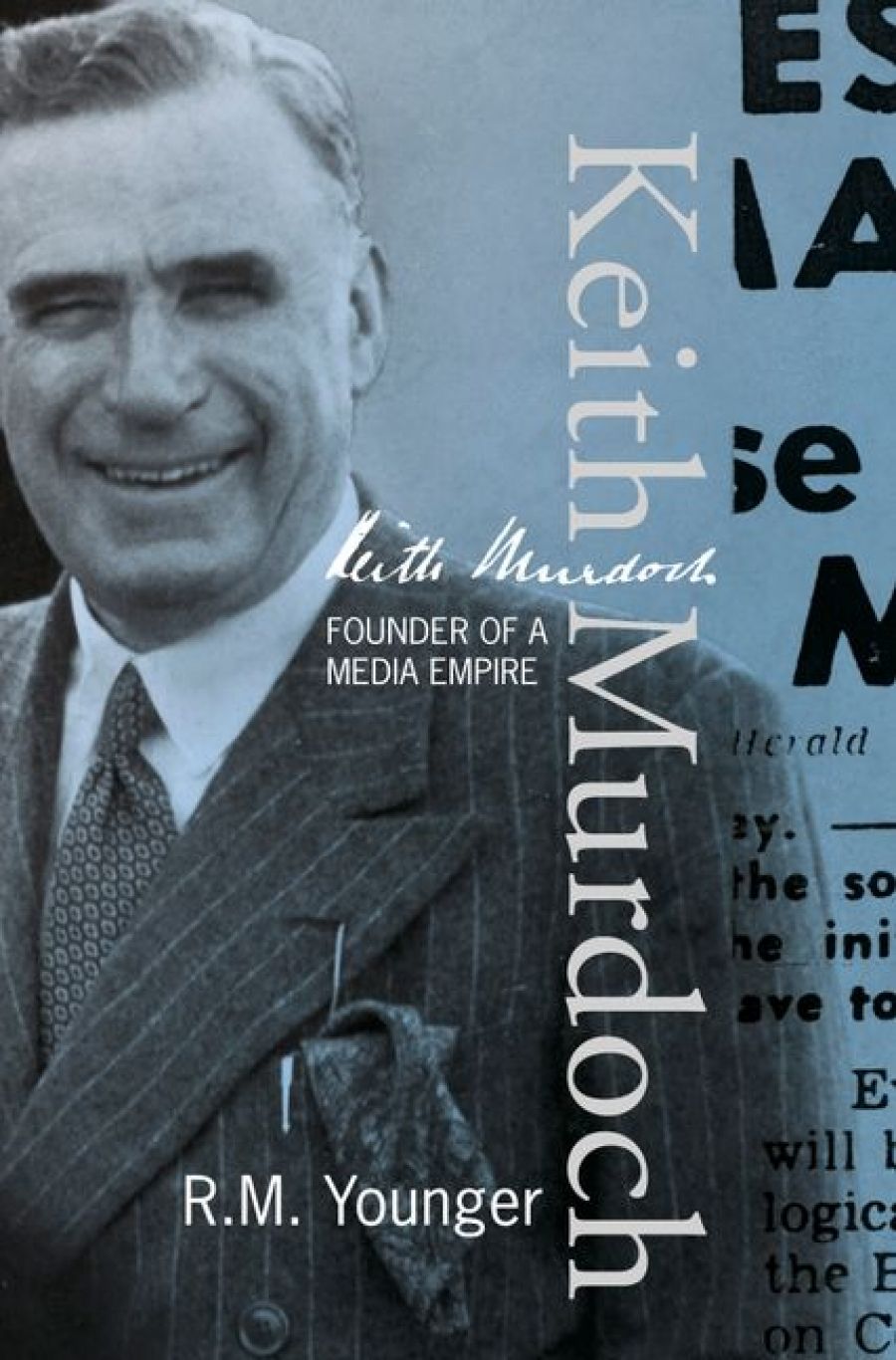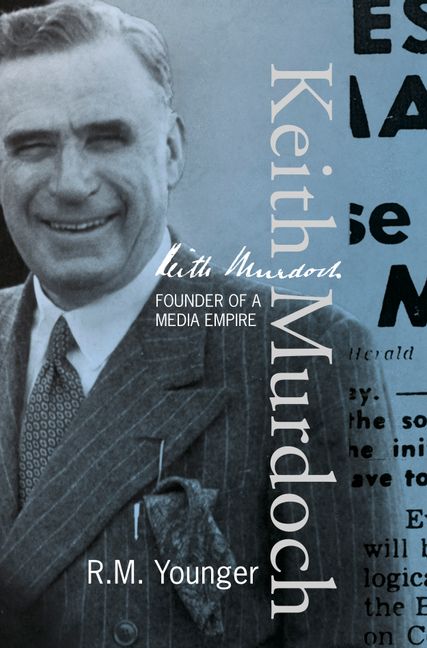
- Free Article: No
- Contents Category: Politics
- Review Article: Yes
- Online Only: No
- Custom Highlight Text:
In the bitter federal election of 1917, Labor’s member for the marginal seat of Corio fell victim to dirty tricks. As a quartermaster sergeant in the AIF’s 3rd Division, A.T. Ozanne shouldn’t have been opposed. But Prime Minister Billy Hughes became electorally desperate, and he published a cable from General Monash, the division’s commander, which portrayed Ozanne as a deserter. Ozanne was indeed not in France with the AIF volunteers, but it was because he had been given medical leave, quite authentically. Monash was careless with the facts, and perhaps misled by officers who disliked Ozanne. Hughes’s ruthless use of the cable destroyed Ozanne’s political career.
- Book 1 Title: Keith Murdoch
- Book 1 Subtitle: Founder of a Media Empire
- Book 1 Biblio: HarperCollins, $49.95 hb, 421 pp
- Book 1 Cover Small (400 x 600):

- Book 1 Cover (800 x 1200):

In Geoffrey Serle’s biography of Monash (1990), this is recorded frankly as a dishonourable episode – but aberrant, which indeed it was. On Murdoch’s part, it was a minor but quite characteristic intrigue. And it doesn’t appear at all in R.M. Younger’s resolutely sycophantic account of News Corporation’s founding father (published by the Newscorp book firm, HarperCollins).
This comparison of biographies should go somewhat deeper. Monash did the kind of thing generals do, as servants of the state, and for once did it badly. Murdoch – effectively, in this case – did something entirely outside journalism’s province. Reporters have no business as agents of those politicians who presently command the state, and, for all our bias and corruption, few of us assume such status with deliberation. Doing so was a Murdoch specialty: one continued today in News Corporation’s reverent service to the chieftains of Washington and Beijing (indeed, to power wherever Newscorp supposes it to flow).
Reverence is a striking quality of Younger’s book, busily selling specious banality as transcendent insight. The Founder, we’re told, conceived that everyone in journalism should ‘realise that it called for fearless and unfailing integrity’. This came to him through his having:
acquired a personal mastery of the newspaper craft through a special level of proficiency in all that he did. He had exceptional ability to distinguish the meritorious from the merely meretricious, the genuine from the false, truth from fabrication in all things. He was able consistently to realise the results that mattered most deeply to him, in effect approaching his life as a newspaperman in the same way an artist might approach a work of art.
Such prose is uncommon under liberal democracy, resembling best North Korean tributes to the Great Leader Kim II Sung and the Dear Leader Kim Jong II.
Keith Murdoch’s one well-known piece of reporting, the Gallipoli Letter of 1915, in fact displays an exceptional inability to distinguish the genuine from the false (and little sign of the attempt). Belief that the letter was significant in saving the Anzacs from Gallipoli has largely vanished from serious history (as Les Carlyon observes in his recent thoroughgoing account of the campaign, Gallipoli, 2001). Younger dutifully exhibits remnants of the myth. However, the real impact of Murdoch’s tirade – though circulated only in secret, it qualified him for recruitment to Northcliffe’s propaganda circus – he scarcely discusses.
But even with Gallipoli discounted, notions persist of Murdoch as a dissenter from the bloody orthodoxy that ruled Allied military theory between 1914 and early 1918. Actually, he was a very diligent conformist, devoting himself – far past anything defensible in a reporter – to propaganda for Hughes and for unsuccessful attempts to cram Australian conscripts into the Western Front meat-grinder, along with British ones. All this Murdoch compounded with an unscrupulous and arrogantly misinformed plot which, if effective, would have concluded with Hughes removing from command the general who finally solved the riddle of the trenches: Monash.
No useful biography of Murdoch is possible without investigating these remarkable episodes of spin-doctoring and intrigue: the issues involved are central to media practice in free societies. It is hard to imagine the outcome as pretty reading, but understanding might emerge: for instance, Murdoch’s training as a journalist was deeply inadequate, as he himself recognised. But Younger ignores the substantive episodes, while absurdly glamourising Murdoch’s apprenticeship in which he was a suburban stringer for The Age, existing on payment by the line. Such systems (a form of sweating, as Murdoch said) make the reporter’s income dependent on those who can offer news – or its likeness – and an urge to ‘distinguish the meritorious from the merely meretricious’ makes life difficult. The corrosive impact on journalistic judgment isn’t considered by Mr Younger – whose main experience seems to be in government public relations – but is visible in media history (see, for example, Max Frankel’s The Times of My Life – and My Life with The Times, 1999). Remarkable men and women have emerged as great reporters from such a background, but Keith Murdoch was not one of them: doubtless there were reasons, but little can be seen through the rich goo in which Younger coats his subject’s youth. (We are told about the stammer and diffidence that afflicted the young reporter, but nothing about when and why it gave way to the articulate bumptiousness seen in Murdoch the political fixer.)
That the Herald was a newspaper with good qualities must owe something to Murdoch, but the exclusion of other contributors – Theodore Fink, most obviously – makes Mr Younger’s estimation worthless. Generally, he inflates his case to bursting: notably when Murdoch appears as a socio-economic sage, lighting the Depression years with Keynesian insights on effective demand. Neither Fink nor Murdoch held an economic notion outside businessmen’s orthodoxy, and their Herald toiled officiously against the smallest Keynesian initiatives of federal treasurer ‘Red Ted’ Theodore. Received wisdom suited Sir Keith, provided he and his allies were dispensing it.
But Fink differed from Murdoch in wanting newspapers and office-holders to maintain some decent distance. Indeed, he commanded the Herald during the early twentieth century, when modern journalism was created – centrally, the ‘commercial-professional newspaper’ as Michael Schudson calls it: the imperfect model that still keeps news media and political authority just sufficiently separated for democracy to survive. To this model, Murdoch gave stentorian lip service but no serious loyalty.
Even on Mr Younger’s hagiograph, the needle flickers when we reach 1940 and Murdoch joins the Menzies government as Director-General for Information – as censor, with powers over every Australian media system. Theoretically, Murdoch stood down from the Herald group. Actually, he retained editorial command. We are told that Sir Keith intended elevating Australian public opinion on the grandest lines. Indeed, he would have transcended Northcliffe’s achievement in World War I, but that idealism blinded him to obstructions from Fink within the Herald group (and almost every newspaper outside it).
Mr Younger’s admiration for Northcliffe’s 1914–18 concoctions is not widely shared today. Murdoch’s plan disintegrated along with Menzies’ administration, seeming in retrospect as absurd as authoritarian failures mostly do. Its sinister potential is reduced in Younger’s account by the absence of Murdoch’s real 1914–18 record, which is necessary to remind us that those who volunteer for the censor’s authority are those least fit to exercise it. The evidence was largely secret in 1940 (though Fink must have had some idea). Today, it is only secret from readers taken in by R.M. Younger.


Comments powered by CComment